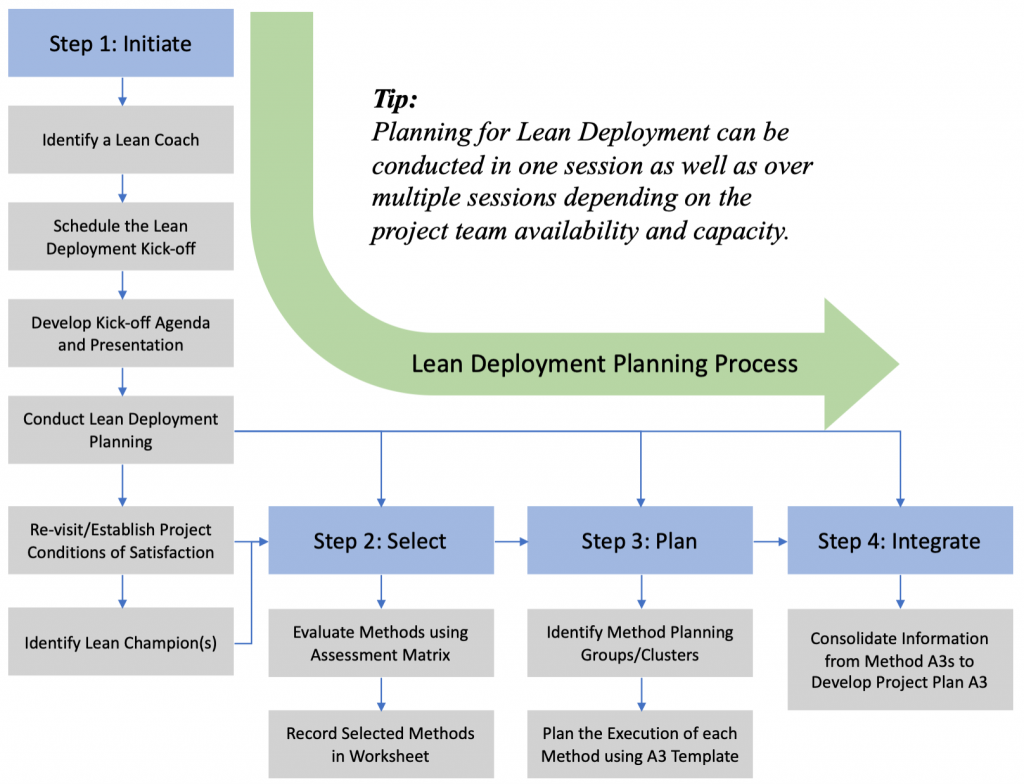2 Planning Procedure Overview
The planning procedure is comprised of four steps. Each step is defined based on research conducted by the Lean Construction Institute to address the consistent implementation of lean at a project level. By identifying current practices in method planning and implementation of lean across projects, these steps were developed to capture the best practices and to minimize the existing challenges supporting lean adoption.

Step 1: Initiate
The key outcome from this step is the organization of a lean deployment planning session that will be attended by key members of the project team. Throughout the lean deployment planning, the goal is to finalize the project’s conditions of satisfaction (P-COS), select methods for lean implementation, plan the selected methods, and integrate the method plans into a project plan. The lean deployment planning can be organized as a one-time session to perform the entire procedure or as several sessions, whichever best suits the project team capabilities and needs.
The lean deployment planning can be made more effective by:
- appointing a lean coach, who has experience conducting lean implementations;
- developing a facilitation agenda and presentation; and
- scheduling sessions for the project team to collaborate.
A prerequisite in developing the lean deployment plan is to have a clear understanding of the client’s needs from the project. The client needs are usually captured in the project conditions of satisfaction (P-COS) during the validation phase and represent the value proposition for the project, which needs to be captured in the lean deployment plan. If the P-COS has not been developed, then it should be discussed and developed collaboratively at the lean deployment planning kick-off with project leaders, who thoroughly understand the client’s needs. Once the P-COS are recorded as part of the plan, the project team leaders need to identify a lean champion, who can be responsible for leading by example during the lean implementation.
Step 2: Select
To deliver the value represented by the project’s COS, the goal of the select step is for the project team to review specific methods in terms of their value versus implementation needs in enabling specific lean processes. For example, work clusters support organization of project team respective to the project’s core performance areas, scope, deliverables, etc. to maximize efficiency and optimize resources. Due to each project being unique, a different approach and set of strategies may be required to meet project specific requirements. Therefore, with every project, a different set of methods also need to be selected that are complementary to each other in delivering the critical project needs. The method assessment matrix and selection worksheet together assist with brainstorming for each method in terms of their value versus opportunities or challenges.
Step 3: Plan
Once the methods are selected for implementation, the team should collaboratively develop the plan for each of the selected methods during the lean deployment planning kick-off/session(s). The method planning A3 template and the method one-page summaries in the guide are intended to help project teams identify and develop the targeted methods. The planning helps to translate the P-COS into an actionable plan that can be measured and continuously improved throughout the project duration.
Step 4: Integrate
Once the implementation plan for each method has been laid out for the project, the project team should work collaboratively to integrate and further develop the metrics, educational plan and communication needed, to track lean implementation at the project level. The goal of the integrate step is to consolidate all the information from the method templates into a project A3. The project A3 is the basis for continuous reflection and improvement of the lean deployment plan. Routine events such as project plan reviews and reflections need to be embedded into the project processes with time and resource commitments to enable the project team to learn and improve. The implementation plan can also be integrated into the project’s management processes, such as scope and cost management or design development, to support overall project delivery using lean deployment.

